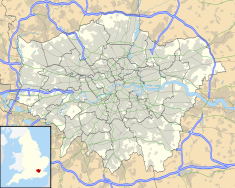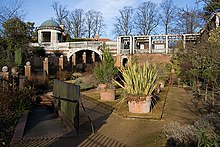
William Butterfield was a British Gothic Revival architect and associated with the Oxford Movement. He is noted for his use of polychromy.
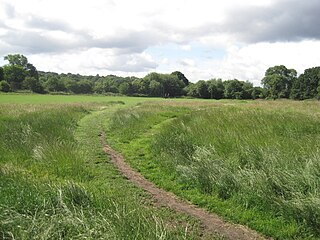
Hampstead Heath is an ancient heath in London, spanning 320 hectares. This grassy public space sits astride a sandy ridge, one of the highest points in London, running from Hampstead to Highgate, which rests on a band of London Clay. The heath is rambling and hilly, embracing ponds, recent and ancient woodlands, a lido, playgrounds, and a training track, and it adjoins the former stately home of Kenwood House and its estate. The south-east part of the heath is Parliament Hill, from which the view over London is protected by law.
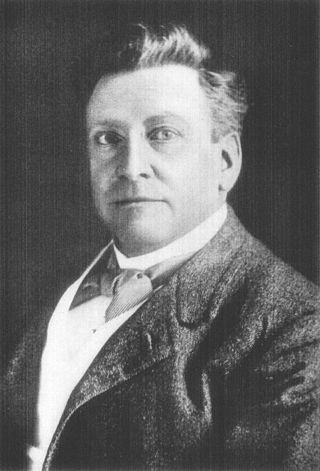
William Hesketh Lever, 1st Viscount Leverhulme, was an English industrialist, philanthropist, and politician. Having been educated at a small private school until the age of nine, then at church schools until he was fifteen; a somewhat privileged education for that time, he started work at his father's wholesale grocery business in Bolton. Following an apprenticeship and a series of appointments in the family business, which he successfully expanded, he began manufacturing Sunlight Soap, building a substantial business empire with many well-known brands such as Lux and Lifebuoy. In 1886, together with his brother, James, he established Lever Brothers, which was one of the first companies to manufacture soap from vegetable oils, and which is now part of the British multinational Unilever. In politics, Lever briefly sat as a Liberal MP for Wirral and later, as Lord Leverhulme, in the House of Lords as a Peer. He was an advocate for expansion of the British Empire, particularly in Africa and Asia, which supplied palm oil, a key ingredient in Lever's product line. His firm had become associated with activities in the Belgian Congo by 1911.

Kenwood House is a former stately home in Hampstead, London, on the northern boundary of Hampstead Heath. The house was originally constructed in the 17th century and served as a residence for the Earls of Mansfield during the 18th and 19th centuries.
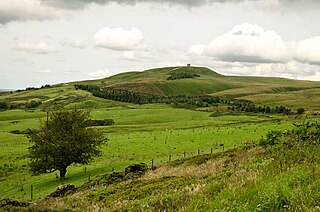
Rivington is a village and civil parish of the Borough of Chorley, Lancashire, England, occupying 2,538 acres. It is about 6 miles (9.7 km) southeast of Chorley and about 8+1⁄2 miles (13.7 km) northwest of Bolton. Rivington is a rural area consisting primarily of agricultural grazing land, moorland, with hill summits including Rivington Pike and Winter Hill within the West Pennine Moors. The area has a thriving tourist industry centred around reservoirs created to serve Liverpool in the Victorian era and Lever Park created as a public park by William Lever at the turn of the 20th century, with two converted barns, a replica of Liverpool Castle and open countryside. Rivington and Blackrod High School is located here. Rivington and its village had a population of 109 at the 2011 Census.

Thornton Hough is a village in the Wirral district of Merseyside, England. The village lies in the more rural inland part of the Wirral Peninsula and is of pre-Norman Conquest origins. The village grew during the ownership of Joseph Hirst into a small model village and was later acquired by William Lever, founder of Lever Brothers, the predecessor of Unilever. Thornton Hough is roughly 10 miles (16 km) from Liverpool and 12 miles (19 km) from Chester. It is part of the Clatterbridge ward and is in the parliamentary constituency of Wirral South.
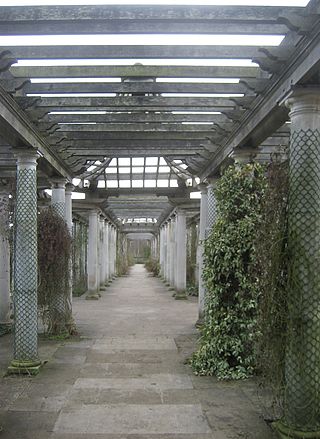
Thomas Hayton Mawson, known as T. H. Mawson, was a British garden designer, landscape architect, and town planner.
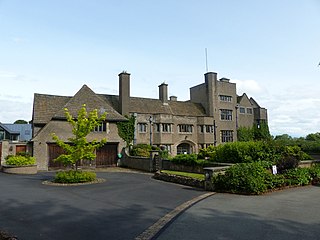
Tirley Garth is a large country house some 2.5 miles (4 km) to the north of Tarporley, Cheshire, England. The house together with its entrance courtyard walls are recorded in the National Heritage List for England as a designated Grade II* listed building.

The architecture of Liverpool is rooted in the city's development into a major port of the British Empire. It encompasses a variety of architectural styles of the past 300 years, while next to nothing remains of its medieval structures which would have dated back as far as the 13th century. Erected 1716–18, Bluecoat Chambers is supposed to be the oldest surviving building in central Liverpool.

Thornton Manor is a large manor house in the village of Thornton Hough, Wirral, Merseyside, England. It is recorded in the National Heritage List for England as a designated Grade II* listed building. The house was first built in the middle of the 19th century and has been altered and extended in a number of phases since. From 1888 to the end of the 20th century the house was occupied by the Viscounts Leverhulme.

Rivington in the Borough of Chorley, Lancashire, is situated on the edge of the West Pennine Moors, at the foot of Rivington Pike overlooking reservoirs created for Liverpool Corporation Waterworks in the 19th century. There are twenty eight listed buildings within Rivington, two are classified by English Heritage as Grade II*, the rest as Grade II; Rivington has no Grade I Listed buildings.

Romford Garden Suburb, is a late-Edwardian housing development in Gidea Park, in the London Borough of Havering. The object of the new suburb, which was built on land belonging to Gidea Hall, then occupied by the Liberal politician Herbert Raphael, was, according to his parliamentary colleague John Burns, to "provide families with a well-built, modern home regardless of class or status" and "to bring the towns into the country and the country into the towns".

Percy Richard Morley Horder was an English architect who early in his career worked from offices in Stroud and later in London. His early work was in the Arts and Crafts style, but after the First World War his buildings were increasingly in the Neo-Georgian fashion. His work included public houses for the Godsell Brewery and designing new country houses or partially rebuilding existing houses. He also designed country-house gardens and is noted for laying out Highfields Park, Nottingham together with the adjacent Nottingham University Campus. He undertook architectural work in many parts of the British Isles including Ireland. He is probably best remembered for the Trent Building in the University of Nottingham. and for design of the London School of Hygiene and Tropical Medicine. His work at Upton House, Warwickshire for Viscount Bearsted is notable, but it is his work for Jesse Boot, both the Boots the Chemists stores, but most importantly the Trent Building and the laying out the campuses of the University of Nottingham, which influenced design at other English universities, for which he must take the greatest credit.

Mount Vernon House is a house in Hampstead in the London Borough of Camden. It has been listed Grade II on the National Heritage List for England (NHLE) since May 1974. The garden wall is separately listed at Grade II. The house was built around 1726 and was altered in the early 19th century. It is rendered in stucco with a mansard roof. The house occupies the site of a windmill. It was constructed between 1725 and 1728 by a local Hampstead timbersmith, William Knight.

Moreton House is a detached house on Holly Walk in Hampstead in the London Borough of Camden. It has been listed Grade II on the National Heritage List for England (NHLE) since December 1969.
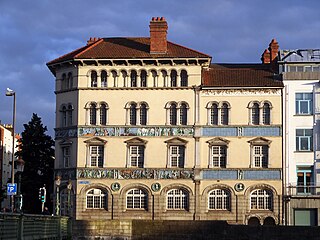
Sunlight Chambers is a commercial office building on the corner of Parliament Street and Essex Quay in the Temple Bar area of Dublin. It was designed by architect Edward Ould in an Italianate style and was named after Lever Brothers' Sunlight detergent brand.

Terraced Gardens of Rivington is a landscaped woodland on the hillside of Rivington Pike, in Rivington Parish in the Chorley Borough of Lancashire, England, originally designed as a Garden by T.H. Mawson and built as curtilage to a home of the soap magnate Viscount Leverhulme; as such, the area is not part of Lever Park. The gardens contains and abuts the SSSI of the West Pennine Moors. Today the former gardens are Grade II listed and contain eleven Grade II structures. The original design had three elements — the upper part being in the romanesque architectural style, the lower section, known as the Ravine, was a woodland with a man-made stream, and a Japanese-style garden, with a man-made pond constructed of Pulmonite which remains today. The gardens are leased to Rivington Heritage Trust by United Utilities and are undergoing restoration and preservation.

Pond Street is located in Hampstead in the London Borough of Camden. It runs eastwards from Rosslyn Hill to South End Green, located in the old "South End" of the settlement. The street takes its name from an ancient pond at South End Green, a source of the River Fleet, and has been known by this name since at least 1678. The pond survived into the Victorian era.
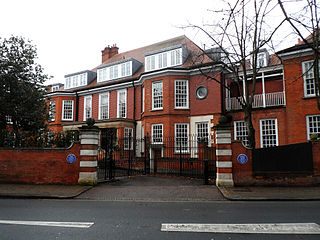
North End Way is a street in Hampstead in the London Borough of Camden, today a stretch of the A502 road. At the boundary with the London Borough of Barnet it becomes North End Road running northwards into Golders Green where it terminates at the junction with Finchley Road, by the tube station. North End Way passes through Hampstead Heath.
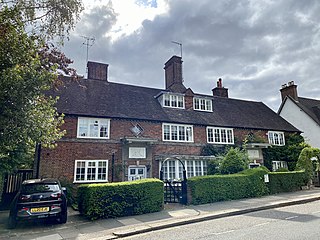
Hampstead Way is a street at the northern edge of Hampstead. It is located primarily in the London Borough of Barnet although its southern end forms a border with the London Borough of Camden in which the rest of Hampstead is located. In the south it is part of the old hamlet of North End, which marked the northern boundary of Hampstead, but then curves northwards and follows the edge of Hampstead Heath into Golders Green and Hampstead Garden Suburb. The southern end leads off North End Way.

